Jul 09, 2011
Wondering what the weather might be like this winter? Why not ask Warmist Jeff Masters?
hauntingthelibrary
Wondering what the weather might be like this winter? Why not ask Warmist Jeff Masters of Weather Underground for a no-nonsense prognosis based on the science of man-made global warming?
As Masters cautioned us in 2006, we should expect more “brown winters” characterised by a lack of snow. As he mournfully told his young nephew, snow is now pretty much a thing of the past, thanks to global warming:
“Will it stay warm? When my nephew Cody eagerly unwrapped his new snow board this Christmas and asked me when he might get a chance to use it, I told him, “What are you thinking? This is Michigan in the 21st century! There’s not going to be any more snow.” I exaggerate slightly, but I donít recommend that anyone invest in the winter sports equipment industry this year. The latest 2-week forecast from the GFS model shows no end in sight for the warm conditions in North America. I’m guessing that our next outbreak of cold Arctic air in the U.S. wonít come until mid-January. According to theInternational Research Institute for Climate and Society at Columbia University (IRI), January through March should be warmer than average across virtually the entire globe.
This lack of snow, Masters lectured us, could be attributed to the melting of the Arctic ice, which was leading to warmer winters and preventing snow from falling:
All this exposed water provides a huge source of heat and moisture in the Arctic that retards the formation of the usual cold air masses over the adjacent regions of Canada and Siberia. Itís impossible to know how much of an effect this has without doing some detailed model studies, but I think the record low sea ice in the Arctic is probably a significant contributor to this winterís record warmth.
All quite clear, and explained with copious references to various graphs, data, and citations. Global warming means melting Arctic ice, means warmer winters and less snow. The science is settled.
Fast forward to 2011, and the series of record-breaking freezing winters and snowfalls across much of the world. Reporting on what he termed “snowmaggedon” Masters breathlessly detailed some of the freezing winter conditions the world had been experiencing:
A series of remarkable snow storms pounded the Eastern U.S., with the “Snowmageddon” blizzard dumping more than two feet of snow on Baltimore and Philadelphia. Western Europe also experienced unusually cold and snowy conditions, with the UK recording its 8th coldest January. A highly extreme negative phase of the NAO and AO returned again during November 2010, and lasted into January 2011. Exceptionally cold and snowy conditions hit much of Western Europe and the Eastern U.S. again in the winter of 2010 - 2011. During these two extreme winters, New York City recorded three of its top-ten snowstorms since 1869, and Philadelphia recorded four of its top-ten snowstorms since 1884. During December 2010, the extreme Arctic circulation over Greenland created the strongest ridge of high pressure ever recorded at middle levels of the atmosphere, anywhere on the globe (since accurate records began in 1948.)
What possible explanation could there be for these freezing conditions and record snowfall? Why, global warming of course. Master’s tentative explanation for all of this was that melting Arctic ice was affecting atmospheric circulation:
New research suggests that major losses of Arctic sea ice could cause the Arctic circulation to behave so strangely, but this work is still speculative.
Of course it is. Makes perfect sense when you subscribe to the notion of man-made global warming. It’s only skeptics that can’t see the logic in this. Global warming means no more snow, and lots more snow. As Orwell put it:
“Day by day and almost minute by minute the past was brought up to date. In this way every prediction made by the Party could be shown by documentary evidence to have been correct; nor was any item of news, or any expression of opinion, which conflicted with the needs of the moment, ever allowed to remain on record. All history was a palimpsest, scraped clean and reinscribed exactly as often as was necessary.”
Jul 08, 2011
Pacific Northwest Coldest April to June on Record; Australia Coldest Autumn since at least 1950
Mark Albright of the University of Washington reports:
According to the National Climatic Data Center, in Washington State, Apr-Jun 2011 was -3.6 deg F below the 1901-2000 (20th century) average, making Spring 2011 the coldest Apr-Jun in the past 117 years:
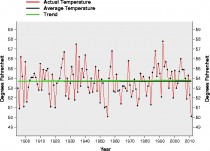
Enlarged.
And yet at the same time we are being asked by the Climate Impacts Group to believe that our snowpack is melting 20 days earlier than before global warming set in across our region:
Water managers are beginning to feel a crunch related to climate change. Springtime melt now starts some 20 days earlier than a half-century ago, which is “pretty unequivocally” seen as a signature of climate change.
Sorry, but I don’t think so!
How about Oregon? Dr.Gordon Fulks reports a record there also.
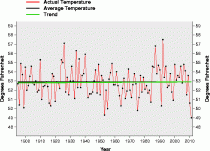
Enlarged.
This is big news indeed. Both Oregon and Washington just experienced the coldest Spring in over a century, using official NCDC data going back 117 years. The April through June period most closely approximates the Spring period. We knew it was cold here but not that cold. Now I better understand why I used so much firewood to keep warm this year.
News agencies should contact Mark Albright (Washington State Climatologist 1987 - 2003) at the University of Washington for further details. He is the one who first noticed this. Mark was among the first to point out that Pacific Northwest temperatures have been trending downward for the last two decades. Professor Cliff Mass, also of the University of Washington, recently pointed out the same downward trending temperatures (although for slightly less than two decades).
All of this obviously runs counter to what climate alarmists have been saying for a long while. In science, data trumps theory every time. If the reverse is true, it is NOT science at all.
AMEN
----------------
BOM reports the coldest spring in Australia since at least 1950
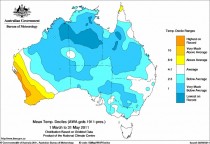
Enlarged.
Australia has experienced its coldest autumn since at least 1950 for mean temperatures (average of maximum and minimum temperatures across the nation) with an Australian average of 20.9C.
This was 1.15C below the historical average, and 0.2C below the previous coolest autumn in 1960. It was also the coldest autumn since at least 1950 for Queensland and the Northern Territory.
Large parts of the country recorded temperatures more than 2ļC below the autumn average (figure 1) with about half the country ranking in the coldest 10% of years. The season was
marked by consistent below-normal temperatures in most areas, with only a few individual areas recording their coldest autumn on record. These areas were in northern and central Australia
including the east Kimberley, the central Northern Territory and small parts of northern Queensland.
The cool conditions experienced in autumn 2011 are largely a result of the strong 2010/11 La Nina event which brought heavy rainfall and cool daytime temperatures to Australia, before decaying in late autumn. Of particular significance was March 2011 - Australia’s coldest and wettest March on record for maximum temperatures and third wettest month on record (for any calendar month).
See PDF analysis.
Can you imagine the story had they not be using the data that Dr Salinger manipulated?
Jul 05, 2011
Science Corruption at the National Academies of Science
By Michael R. Fox, PhD
Since the proponents of global warming are being caught without providing supporting evidence, the theory of man-made global warming is being destroyed before our very eyes. With no hardnosed physical evidence, measurable, observable, replicable evidence, the fiction has been sustained by non-science methods. These include appeals to authority, existence of an elitist scientific consensus, computer models none of which produce physical evidence.
Crippling national energy policies, environmental policies, economic policies are being seriously considered. Such suicidal policies did not originate in the recent fictions of climate change, but from the leaders of the UN and the Intergovernmental Panel on Climate Change (IPCC) and their friends within the American leadership.
Consider the statement from Maurice Strong, original head of the IPCC - “Isn’t the only hope for the planet that the industrialized civilizations collapse? Isn’t it our responsibility to bring that about?” This is a very destructive agenda proposed for the US and other free nations by the IPCC, which was met with thundering applause by the thousands of international leftists in Rio. They pretend to be peace-loving but definitely are not. New policies by state and federal agencies, which could cost trillions, cripple our economy, and destroy our nation, seem to be the awful agendas of many federal and state agencies and their leaders as well as the agenda of Maurice Strong and the IPCC.
One of the participants in the national climate debate has been the National Academies of Science (NAS). Many Congressmen love associating themselves with members the NAS, with many having never taken a science course in their educational careers. But over the years a major problem has been discovered with members of the NAS and the policy statements they produce.
As described by Chris Horner in his book Power Grab, the membership process to the NAS was corrupted more than 20 years ago. Much of the good science has disappeared as has the sound science policy dependent upon sound science. A backdoor policy for NAS membership has opened to nearly any green leftists seeking membership. They now control future membership, as well as the style and content of NAS reports. Instead we are getting documents from the NAS which are nearly void of hard-nosed scientific evidence and written in the vague meaningless terms of politic correctness.
Recently the NAS released a report entitled “America’s Climate Choices” discussing our future energy sources and our CO2 emission (here). Predictably, it was written in the familiar styles of vague political correctness. One obvious solution to many of these energy problems could be solved with an actively supported nuclear energy program. The NAS did not mention this obvious solution. For the record there are currently 67 nuclear power plants under construction around the world (20 of them in China).
Remarkably, Paul C. Knappenberger, a subject matter expert has written an outstanding 20 page analysis of the NAS report. It is posted here.
He summarizes “In these in-line comments (indicated in red font) we will demonstrate, citing results from the peer-reviewed scientific literature and using data available from government web sites, that the certainties that the NAS panel assigns both to the causes of climate change and to its risk to human and natural systems belie the underlying scientific evidence.”
He catches the NAS overstating the scientific certainties (there are many throughout this discredited theory) of man-made global warming hypothesis. Overstating certainties is just another way to exaggerate all claims. Regrettably the NAS, leading science organization in the US, failed the obvious point, which is that it never stated that man-made CO2 is a climate problem. It simply assumed it to be true, and then proposes a program of energy rationing and economic suicide as a program for the US to mitigate the assumed non-problem of man-made CO2.
Jul 04, 2011
Energy giants want billions for back-up to windfarms
This Is Money
Britain’s richest energy companies want homeowners to subsidise billions of pounds worth of gas-powered stations that will stand idle for most of the time.
Talks have taken place between the Government, Centrica, owner of British Gas, and other energy companies on incentives to build the power stations needed as back-ups for the wind farms now being built around the country.
It is understood 17 gas-fired plants worth about 10 billion pounds will be needed by 2020.
Bad News: Energy department warns light may go out if wind doies down
More...Why the 250bn wind power industry could be the greatest scam of our age
The Energy Department has been warned that without this massive back-up for the new generation of heavily subsidised giant wind farms, the lights could go out when the wind dies down.
Sam Laidlaw, chief executive of Centrica, said renewables, such as large-scale wind energy, were intermittent and required back-up generation, a role gas was uniquely qualified to fill.
But as power stations that operate only intermittently would not be financially viable, Laidlaw said: ‘The building of new gas-fired capacity must be incentivised so that gas can fulfil its role as a bridging fuel.’ To that end, energy companies are asking the Government for ‘capacity payments’. This ensures firms are paid a fee all year round for keeping a plant on standby.
As in previous subsidies, homeowners would be asked to pay for them through yet another levy on their fuel bills, which are already expected to soar by up to 20 per cent this year alone. The Department is considering the request from energy companies and an answer is expected in a new energy White Paper due later this year.
Industry sources insist the Government has no alternative but to agree to the ‘capacity payments’ for standby generation if it wants wind power, which also receives huge subsidies, to provide one-third of Britain’s energy needs.
In winter, when the most intense cold period coincides with a high pressure front, most wind turbines do not work.
One industry executive said: ‘Why would we build a power station - costing about 600 million pounds - that is guaranteed to make a loss because it is not used most of the year?’
By 2020, most of Britain’s nuclear plants, old gas-fired plants and coal-fired power stations will be closed, leaving a 30 per cent energy gap to be filled by more new nuclear plants and more wind power. British Gas managing director Phil Bentley has warned prices will have to rise by at least 15 per cent to compensate for the soaring cost of wholesale gas.
Meanwhile the oil price dropped again on fears over the global slowdown.
Jul 03, 2011
Arctic Temperatures and Ice - Why it is All About Natural Variability
By Joseph D’Aleo, CCM
A story in today’s HUFFPO “Warming Ocean Could Melt Ice Faster Than Thought” Jianjun Yin of the University of Arizona and colleagues report the warming water could mean polar ice melting faster than had been expected. Their report was published Sunday in the journal Nature Geoscience. Co-author Jonathan T. “We have to get rid of the Medieval Warm Period” Overpeck, co-director of the University of Arizona’s Institute of the Environment, said: “This paper adds to the evidence that we could have sea level rise by the end of this century of around 1 meter and a good deal more in succeeding centuries.” Reading the comments show how much in the dark the AGW proponents are. Such a sad state of affairs. They are so dismissive and downright ignorant of the topic they so boldy comment on. They believe we are solely focused on Al Gore and have no scientific basis for skepticism. I wish we could tie them down into a seat and make them hear the truth...someday.
If you don’t think to these people AGW is a religious see the later post about the end times.
-----------
If anyone finds the notion that warm water would melt ice faster than cold water startling please write me. This is not news. It has been suggested in posts and peer review papers for many years, warmer water’s intrusions into the arctic cause ice to diminish in predictable cycles, cycles that have precious little to do with carbon dioxide.
On October 21st the Associated Press hit the wires with a story entitled ”Sea Ice Melting as Arctic Temperatures Rise.”
The temperatures in the arctic have indeed risen in recent years and ice has declined, bottoming out in 2007 but it is not unprecedented nor unexpected. The arctic temperatures and arctic ice extent varies in a very predictable 60-70 year cycle that relates to ocean cycles which are likely driven by solar changes.
In 2007, NASA scientists reported that after years of research, their team had assembled data showing that normal, decade-long changes in Arctic Ocean currents driven by a circulation known as the Arctic Oscillation was largely responsible for the major Arctic climate shifts observed over the past several years. These periodic reversals in the ocean currents move warmer and cooler water around to new places, greatly affecting the climate. The AO was at a record low level last winter explaining the record cold and snow in middle latitudes. A strongly negative AO pushes the coldest air well south while temperatures in the polar regions are warmer than normal under blocking high pressure. See post here.
We agree. And indeed both oceans play a role. In the record-setting (since satellite monitoring began in 1979) summer melt season of 2007, NSIDC noted the importance of both oceans in the arctic ice.
“One prominent researcher, Igor Polyakov at the University of Fairbanks, Alaska, points out that pulses of unusually warm water have been entering the Arctic Ocean from the Atlantic, which several years later are seen in the ocean north of Siberia. These pulses of water are helping to heat the upper Arctic Ocean, contributing to summer ice melt and helping to reduce winter ice growth.
Another scientist, Koji Shimada of the Japan Agency for Marine-Earth Science and Technology, reports evidence of changes in ocean circulation in the Pacific side of the Arctic Ocean. Through a complex interaction with declining sea ice, warm water entering the Arctic Ocean through Bering Strait in summer is being shunted from the Alaskan coast into the Arctic Ocean, where it fosters further ice loss. Many questions still remain to be answered, but these changes in ocean circulation may be important keys for understanding the observed loss of Arctic sea ice.”
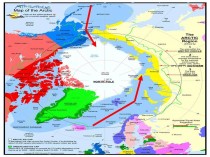
Enlarged here.
The Pacific warm mode favors more El Ninos and warmer water in the far northern Pacific including the Bering Straits. The PDO flipped into its warm mode in 1978 and the arctic temperatures began to warm and ice began to melt.

Enlarged here.
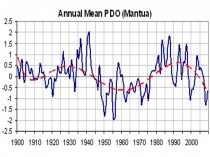
Enlarged here.
Notice how the temperatures in Alaska go through step changes tied to the PDO (Keen).
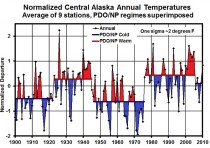
Enlarged here.
The Atlantic also cycles on a 60-70 year period. The Atlantic Multidecadal Oscillation or AMO returned to the positive warm mode in 1995.
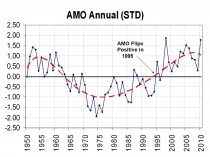
Enlarged here.
Frances et al. (GRL 2007) showed how the warming in the arctic and the melting ice was related to warm water (+3C) in the Barents Sea moving slowly into the Siberian arctic and melting the ice. She also noted the positive feedback of changed “albedo” due to open water then further enhances the warming.
The International Arctic Research Center at the University of Alaska, Fairbanks showed how arctic temperatures have cycled with intrusions of Atlantic water - cold and warm.
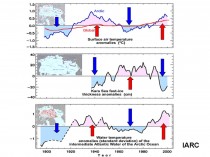
Enlarged here.
The correlation was also confirmed by Juraj Vanovcan.
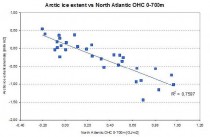
Enlarged here.
See how quickly the arctic ice reacts to warming of the Atlantic sea surface temperatures in 1995 (source Cryosphere Today). This marked a second leg down. We have seen large swings after the big dip in 2007 following a peak in Atlantic warmth in 2004-2005.
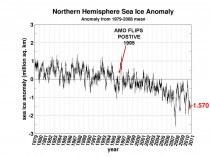
Enlarged here.
Although the PDO and AMO are measured differently, both reflect a tri-pole of ocean temperatures. Both have warm north and tropics and cool relative to normal in between in the positive phase and cold north and tropics and warm in between in the negative phase. By normalizing the two data sets and then adding the two, you get a measure of net warmth or cooling potential for both global and arctic temperatures. See how well the sum tracks with the arctic temperatures. Though we don’t have measurements of ice extent, there are many stories and anecdotal evidence that arctic ice was in a major decline from the 1920s to 1940s.

Enlarged here.
At the edge of the arctic Greenland behaves in the same way - with warming and cooling tied to the AMO.
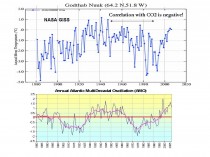
Enlarged here.
Dr. Willie Soon has shown how the arctic temperatures match the solar Total Solar Irradiance (Hoyt/Schatten/Willson) well. Correlation is poor with CO2.
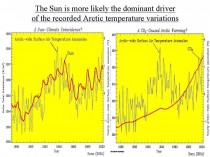
Enlarged here.
We see here how the annual TSI and annual PDO+AMO track together with arctic temperatures.
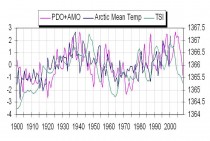
Enlarged here.
Though the current spike in the Atlantic temperatures and more high latitude blocking may cause another spike of melting in the next few winters as warm water from the AMO pop the last year works its way into the arctic, longer term you can expect arctic temperatures to decline and ice to rebound as the Pacific stays cold and the Atlantic cools and the sun stays in its 213 year Eddy minimum.
That doesn’t preclude some very cold and snowy winters short term. In 2008 glaciologist Bruce Molnia reported a bitterly cold Alaskan summer of 2008 following a La Nina winter with extreme cold and heavy snows resulted in area glaciers to expand, rather than shrink for the FIRST TIME IN RECORDED HISTORY. Summer temperatures, which were some 3 degrees below average, allowed record levels of winter snow to remain much longer, leading to the increase in glacial mass for the first time in at least 250 years.
See PDF here. See Verity Jones recent post on the arctic data here. See more on glaciers and icecaps here.
See post by Arnd Bernaerts on Verity Jones’ Digging in the Clay here with much more on the arctic. See also here how the decade is almost up for the arctic ice disappearing here. See this post by Steve Goddard on Greenland glaciers and sea level.
|

















